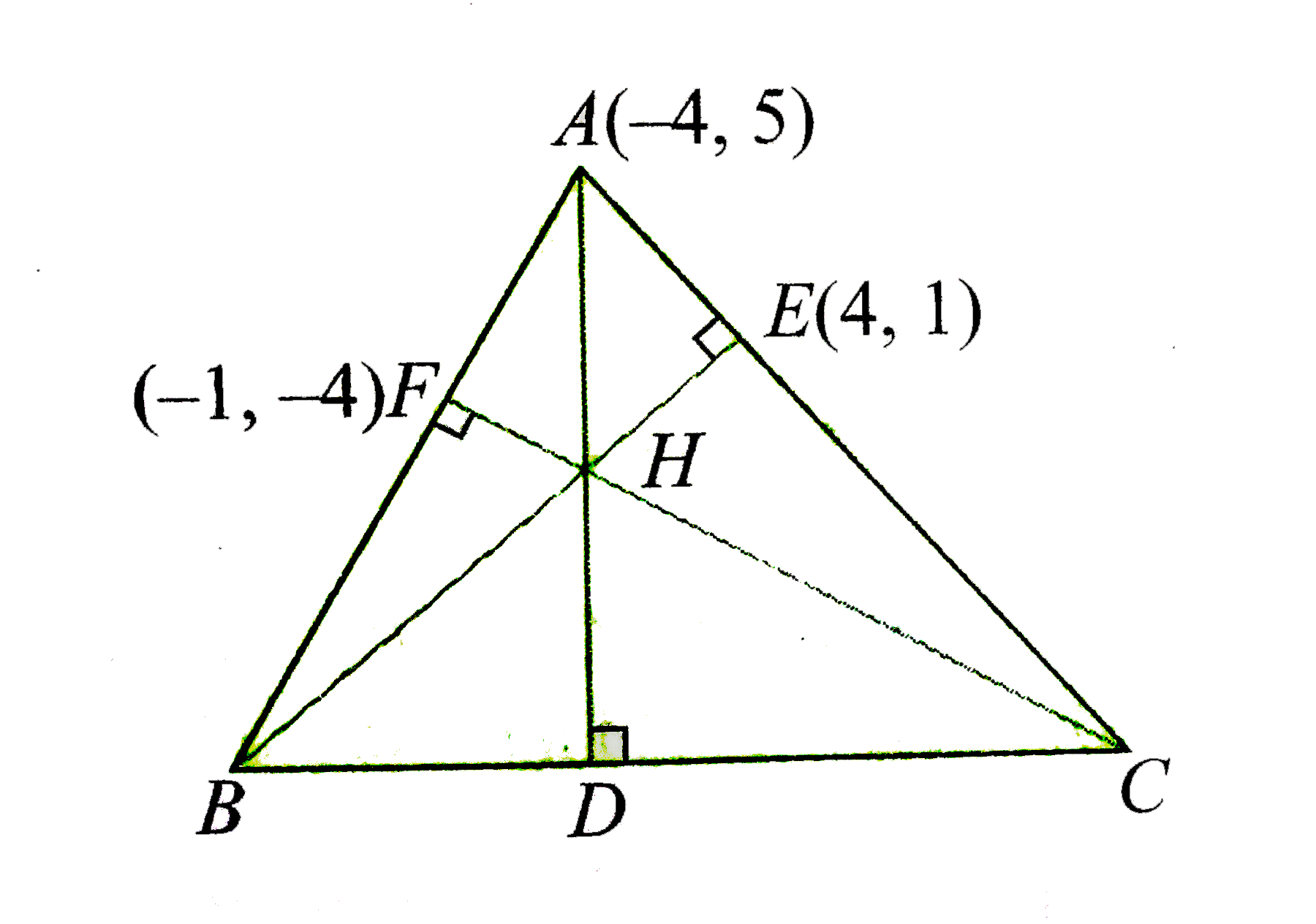If AD, BE and CF are the altitudes of ΔABC whose vertex A is (-4,5). The coordinates of points E and F are (4,1) and (-1,-4), respectively. Equation of BC isSolution in Tamil
3x-4y+28=0
4x+3y+28=0
3x-4y-28=0
x+2y+7=0
The correct Answer is:C

Slope of AB =5−(−4)−4+1=−3
∴ Equation of AB≡3x+y+7=0 (1)
Slope of CF=13
∴ Equation of CF≡x−3y−11=0 (2)
Slope of AC=5−1−4−4=−12
∴ Equation of AC≡x+2y−6=0 (3)
Slope of BE≡2
∴ Equation of BE≡2x−y−7=0 (4)
Solving (1) and (4), we get B≡(0,−7).
Solving (2) and (3), we get C≡(8,−1).
Slope of BC=−7+10−8=34
∴ Equation of BC≡3x−4y−28=0
Topper's Solved these Questions
- BOOK - CENGAGECHAPTER - STRAIGHT LINESEXERCISE - Exercise (Multiple)30videos
STRAIGHT LINES
- BOOK - CENGAGECHAPTER - STRAIGHT LINESEXERCISE - Exercise (Comprehension)27videos
STRAIGHT LINES
- BOOK - CENGAGECHAPTER - STRAIGHT LINESEXERCISE - Exercise 2.65videos
STRAIGHT LINES
- BOOK - CENGAGECHAPTER - STRAIGHT LINEEXERCISE - Multiple Correct Answers Type8videos
STRAIGHT LINE
- BOOK - CENGAGECHAPTER - THEORY OF EQUATIONSEXERCISE - JEE Advanced Previous Year9videos
THEORY OF EQUATIONS
Similar Questions
If P is a point (x,y) on the line y=−3x such that P and the point (3, 4) are on the opposite sides of the line 3x−4y=8, then x>815 (b) x>85 y<−85 (d) y<−815
12:50View SolutionLet L be the line belonging to the family of straight lines (a+2b) x+(a-3b)y+a-8b =0, a, b ∈R, which is the farthest from the point (2, 2).
Area enclosed by the line L and the coordinate axes is03:30View SolutionIf aandb are two arbitrary constants, then prove that the straight line (a−2b)x+(a+3b)y+3a+4b=0 will pass through a fixed point. Find that point.
03:43View SolutionThe point P(α,α+1) will lie inside the triangle whose vertices are A(0,3),B(−2,0) and C(6,1) if
04:26View SolutionQ. Let p and q real number such that p≠0,p2≠q and p2≠−q. if α and β are non-zero complex number satisfying α+β=−p and α3+β3=q, then a quadratic equation having αβ and βα as its roots is
03:47View SolutionAD BE and CF are the medians of a Delta ABC .Prove that 2(AD+BE+CF)<3(AB+BC+CA)<4(AD+BE+CF)
11:51View SolutionIn given figure the altitudes AD, BE and CF , the altitudes of triangle ABC are equal. Prove that ABC is an equilateral triangle.
View SolutionIf D, E and F be the middle points of the sides BC,CA and AB of the ΔABC, then AD+BE+CF is
View SolutionAD, BE and CF, the altitudes of ABC are equal. Prove that ABC is an equilateral triangle.
05:55View SolutionIf D, E, F are the mid points of the side BC, CA and AB respectively of a triangle ABC, write the value of →AD+→BE+→CF.
09:05View SolutionIf AD, BE and CF are the altitudes of ΔABC whose vertex A is (-4,5). The coordinates of points E and F are (4,1) and (-1,-4), respectively. Equation of BC is
08:07View SolutionIf AD,BE and CF are the altitudes of a triangle ABC whose vertex A is the point (−4,5). The coordinates of the points E and F are (4,1) and (−1,−4) respectively, then equation of BC is
04:02View SolutionLet D, E and F be the middle points of the sides BC,CA and AB respectively of a triangle ABC. Then, AD + BE + CF equals to
03:25View SolutionΔABC की भुजाओ BC, CA,AB के मध्य D,E ,F बिंदु है , तो −−→AD+−−→BE+−−→CF=…………
09:24View SolutionIf AD, BE and CF are the altitudes of ΔABC whose vertex A is (-4,5). The coordinates of points E and F are (4,1) and (-1,-4), respectively. Equation of BC is
04:52View SolutionIf AD,BE and CF are the altitudes of a triangle ABC whose vertex A is the point (−4,5). The coordinates of the points E and F are (4,1) and (−1,−4) respectively, then equation of BC is
05:45View Solution

